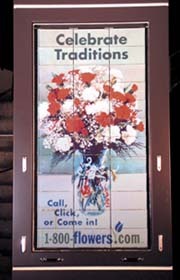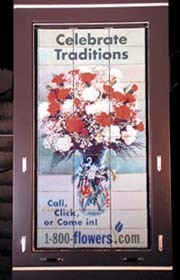The updateable billboard tested by Mitsubishi Electric Corp. represents a major technological shift in out-of-home advertising. The project is the first phase in a greater revolution that will move billboards one more step along the transformation curve from sign" to broadcast medium. Manufactured in Nagasaki by Mitsubishi Electric Corp., this 10 x 20-ft. unit licenses "digital-ink" technology developed by Neveh-Ilan, Israel-based Magink Display Technologies Inc. (see ST , August, page 88). Although it resembles a conventional sign face (with the exception of a slight grid pattern where the 7 x 14-in. modules fit together), the Mitsubishi billboard is fundamentally different. Rather than cranking up the grand-format inkjet machine, you only need a 200Kb JPEG file as artwork to display an image on this billboard. Rather than dispatching a crew and crane with a new vinyl-graphic wrap, you can refresh the image by simply clicking on "Send." The billboard can display as many messages as the operator chooses to schedule. The Magink™ display substrate is a full-color, programmable electronic medium created by sandwiching an electronically charged paste between glass or plastic substrates. In simple terms, the Magink display surface changes the color wavelength and density of the light it reflects in response to the transmitted electronic signal. This is not an emissive technology (as found in an electronic LED sign), but rather a thin reflective film that most closely matches the "electronic ink" category of updateable display technology. A low-energy signal is required to change the graphic, but no electrical current is required to maintain the image. The image is fully visible in daylight and illuminated for night viewing using standard floodlights. Retrofitting an existing billboard with Magink can run up to $80,000-$90,000 for a poster-panel-sized unit (approximately 12 x 24 ft). This price tag is balanced over the long run by the elimination of the costs associated with image printing and installation, and by much lower maintenance requirements. If billboard operators can generate significantly more revenue selling more ad spots per billboard, the ROI will be very attractive. Six units manufactured by Mitsubishi are being beta-tested by key international clients. Five of these clients are large-scale media operators, who see the opportunity to plug billboards seamlessly into larger, multimedia, brand-support campaigns. The units will be tested in lab environments for the first month or so, then installed in "real" outdoor sites this spring. Mitsubishi sources indicate the company is ready to begin mass production immediately once clients are satisfied with the unit’s performance.


 Photo Gallery7 days ago
Photo Gallery7 days ago
 Ask Signs of the Times1 week ago
Ask Signs of the Times1 week ago
 Paula Fargo4 days ago
Paula Fargo4 days ago
 Real Deal1 day ago
Real Deal1 day ago
 Benchmarks2 weeks ago
Benchmarks2 weeks ago
 Photo Gallery4 days ago
Photo Gallery4 days ago
 Women in Signs1 week ago
Women in Signs1 week ago
 Women in Signs1 week ago
Women in Signs1 week ago
















